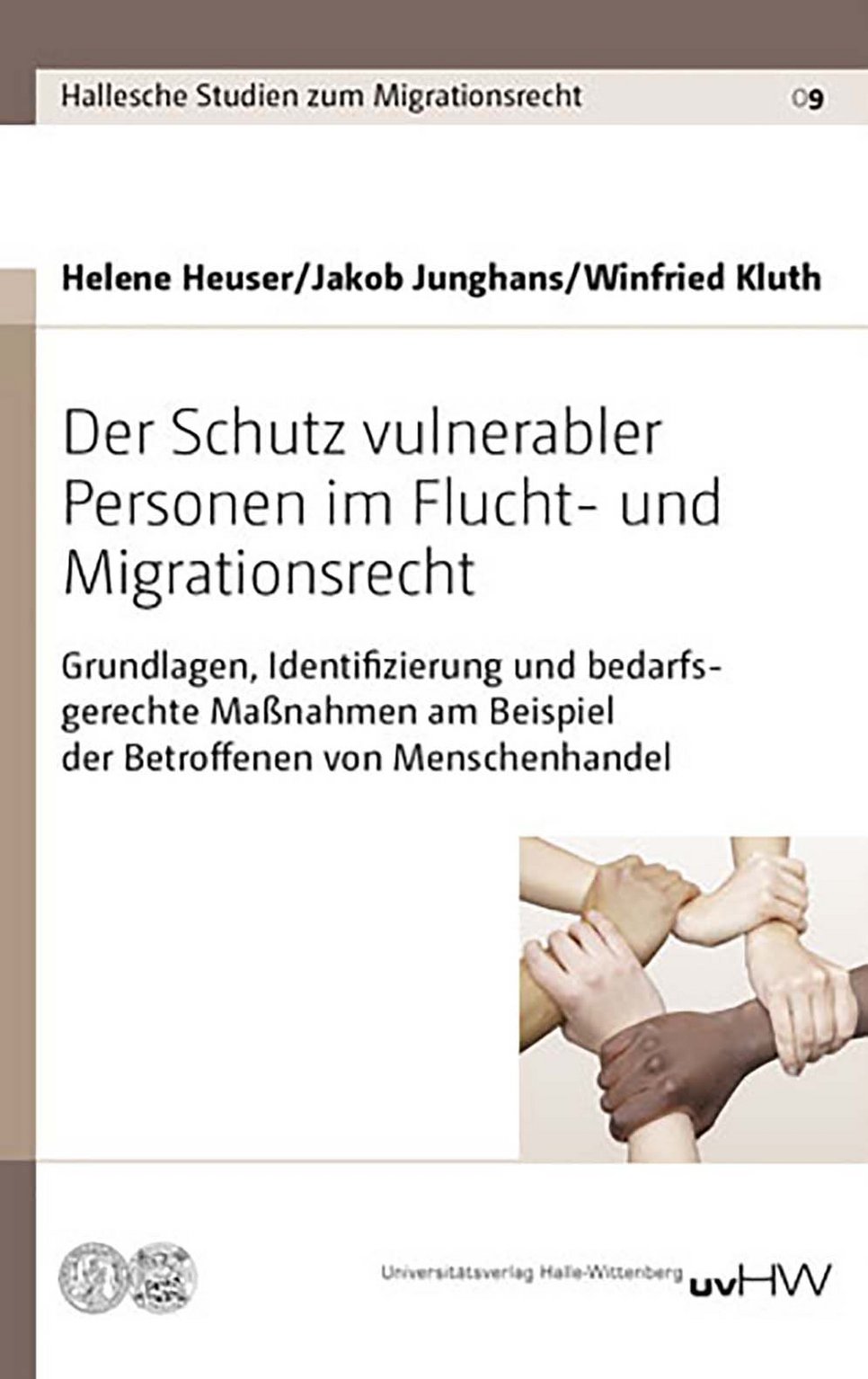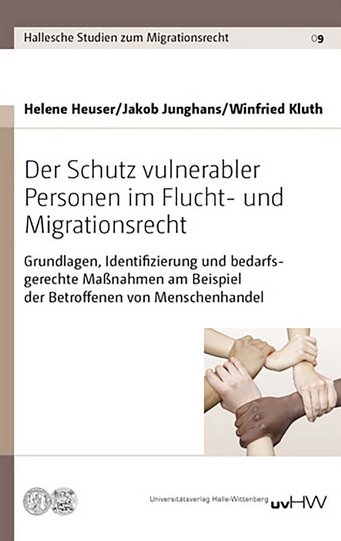Book Publication: The Protection of Vulnerable Persons in Refugee and Migration Law
Basics, Identification and needs-based Measures illustrated by the Example of Victims of Human Trafficking
Helene Heuser | Jakob Junghans | Winfried Kluth - Martin Luther University Halle-Wittenberg

This book has been published as part of the EU Horizon 2020 VULNER research project and presents in a detailed way the intermediate research results of the German VULNER team, based on the first phase of the project, which consisted of mapping out the vulnerability assessment mechanisms developed by state authorities in Germany, including how they are implemented on the ground through the practices of the public servants in charge.
The research was conducted on the example of trafficked persons as one vulnerable group in the sense of the Reception Conditions Directive 2013/33/EU (hereinafter: RCD). The special focus on this group of people is also expressed by five comments written by practitioners from different perspectives on the obstacles to identifying trafficked persons and providing them with the appropriate care.
The book focuses on four aspects:
(1) The interplay of the international, EU and federal levels in a multilevel legal system.
(2) A systematic analysis of the existing norms, their implementation and efficacy.
(3) The special regulations and procedures relating to victims of human trafficking.
(4) The importance of different infrastructural settings (especially regarding the activities and services of specialized NGOs) in the different parts of Germany and their effects on satisfying the special reception and procedural needs (special needs) of vulnerable migrants and protection seekers in general and victims of human trafficking in particular.
This is just the first phase of the data collection process. We are now conducting ethnographic fieldwork to reach a more profound understanding of migrants’ own experiences of vulnerability. The objective is to document and reflect on how these experiences are shaped, and sometimes even produced, by the legal frameworks and state practices. Our ultimate objective is to reflect upon thoroughly and from a critical perspective on the increasing use of ‘vulnerability’ as a standard that guides the development and implementation of migration policies at EU and global levels. On the other hand, in German law and legal research, the term and topic “vulnerability” are mentioned in various research contexts, but they are not given a centralised and unified definition and orientation. Therefore, it is not easy to find thematically relevant studies with corresponding database queries because they may utilise other key terms.
Because of the multilevel regulation we had to analyse the international, European and national legal framework. Concerning the EU level, we mainly analysed the RCD and the Asylum Procedures Directive (APD). Both oblige EU Member States to identify vulnerable individuals during the asylum process and to provide them with specialised assistance. In addition, further European and international regulations were considered, especially those focusing on human trafficking such as the European Directive on Trafficking in Human Beings or the Council of Europe Convention on Action against Trafficking in Human Beings.
Due to the federalised system in Germany, two different procedures were examined. Firstly, the German asylum procedure, which is uniformly regulated by the federal level (Bund). Secondly, the reception procedures and accommodation systems, which are left to each German state (Länder), so that 16 different reception procedures were examined here. As there is a separate legal framework for unaccompanied minors, this was not included in the previous research. It will be addressed in the second phase of the project.
Therefore, at national level we mainly analysed the relevant regulations of the German Reception Act and Asylum Act. Because the 16 Länder are responsible for most relevant aspects of the reception procedure and its corresponding legislation, we found a great variety of different approaches, measures and instruments for addressing the vulnerabilities of asylum seekers (eg. binding/non-binding parliamentarian acts, decrees, administrative instructions, contracts and strategic concepts).
In German federalism the obligation to identify vulnerable protection seekers concerns on the one hand the Bund and on the other hand the Länder, including municipalities (Kommunen). In this system the Bund carries out the asylum procedure, whereas the Länder and Kommunen are responsible for reception in respective accommodation facilities or apartments. Together they have to guarantee identification of vulnerable individuals and address their special needs.
However, Germany has inconsistently applied these EU directives in its own practice. So far, the federal Asylum Act only briefly mentions the obligation to identify vulnerable people, referring broadly to “women” and “persons in need of special protection” (besonders schutzbedürftige Personen). Furthermore, it passes on this responsibility to the Länder, whose regulations and practices for reception procedures vary greatly. The Asylum Act does not contain any legal guidelines regarding the identification procedure for which the BAMF, and thus the federal level, is responsible.
Protection concepts against violence (Gewaltschutzkonzepte), here understood as a formal legal frame- work for reception centres, serve as the main way to address vulnerability in the Länder. Their implementation differs widely (regulations, administrative regulations, advices, contracts). Conversely, concrete legislative considerations of special needs remain the exception. The executive branch thus becomes a key actor – not only in implementation, but also in normatively addressing the needs of vulnerable protection seekers in general.
Regardless of the type of regulation, their references to single vulnerability criteria are as common as substantial considerations of vulnerability in general. In addition to minors, this frequently affects (pregnant) women, single parents and, in some cases, LGBTI+. This gives us an idea of the German understanding of vulnerability. Nevertheless, comprehensive consideration of vulnerability is necessary for implementing the RCD. Differentiation between vulnerable groups can and must be made only in the case of needs-based support and within the framework of protection concepts.
Accommodation in collective reception centres applies in principle to all protection seekers. The explicit promotion of mass accommodation must be viewed through a critical lens especially with regard to its risks for vulnerable persons. Although the importance of protection concepts has received increased attention in recent years, it must be remembered that even with consistent adherence to protection measures, the obligation to live in a mass accommodation per se is often not compatible with needs-based care.
The book comes to the conclusion, that although the awareness of the special needs of vulnerable protection seekers in Germany is increasing, it is not yet sufficiently legally implemented in comparison with the provisions of international and European Law. Therefore, the asylum and reception procedure should be reformed, so that the identification and consideration of vulnerable persons is regarded as an integral part in the procedures in all parts of Germany.
Content
- The special needs of vulnerable persons within the system of European and German migration law (W. Kluth) – 11
- The identification of vulnerabilities in the asylum procedure using the example of trafficked persons (H. Heuser) – 31
- Vulnerable protection seekers within the reception procedures of the federal states (J. Junghans) – 77
- Comment: An identification model for victims of human trafficking (N. Frei) – 137
- Comment: The Council of Europe Convention on Action against Trafficking in Human Beings: Impulses for the accommodation of victims of trafficking in human beings (N. Allenberg & N. González Méndez de Vigo) – 145
- Comment: The relevance of training and educational concepts on the phenomenon of trafficking in human beings in public administration (S. Blücher) – 153
- Comment: Ultimate career challenge for high potentials – Counselling and Representation of Trafficked Persons and other vulnerable persons (C. Lindner) – 161
- Comment: What are the psychological obstacles to identifying trafficked persons in initial reception and registration centres (E. Tambini Stollwerck & C. Nikendei)? – 167
